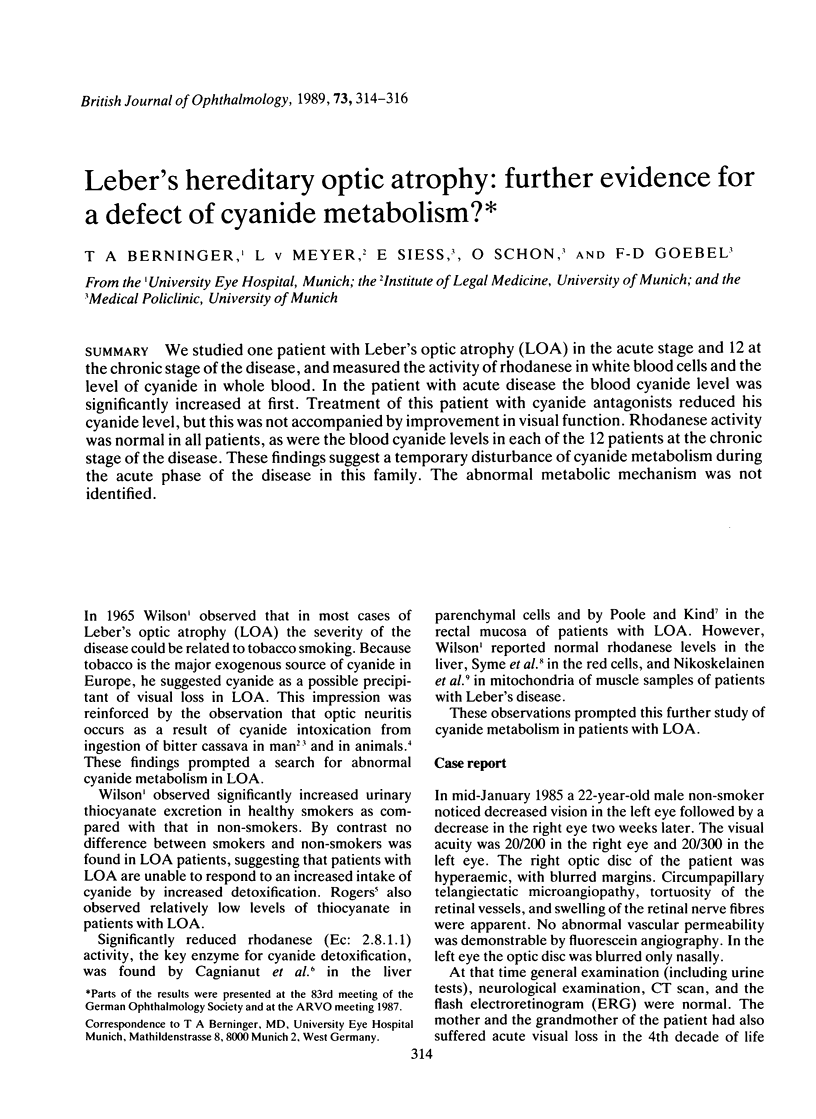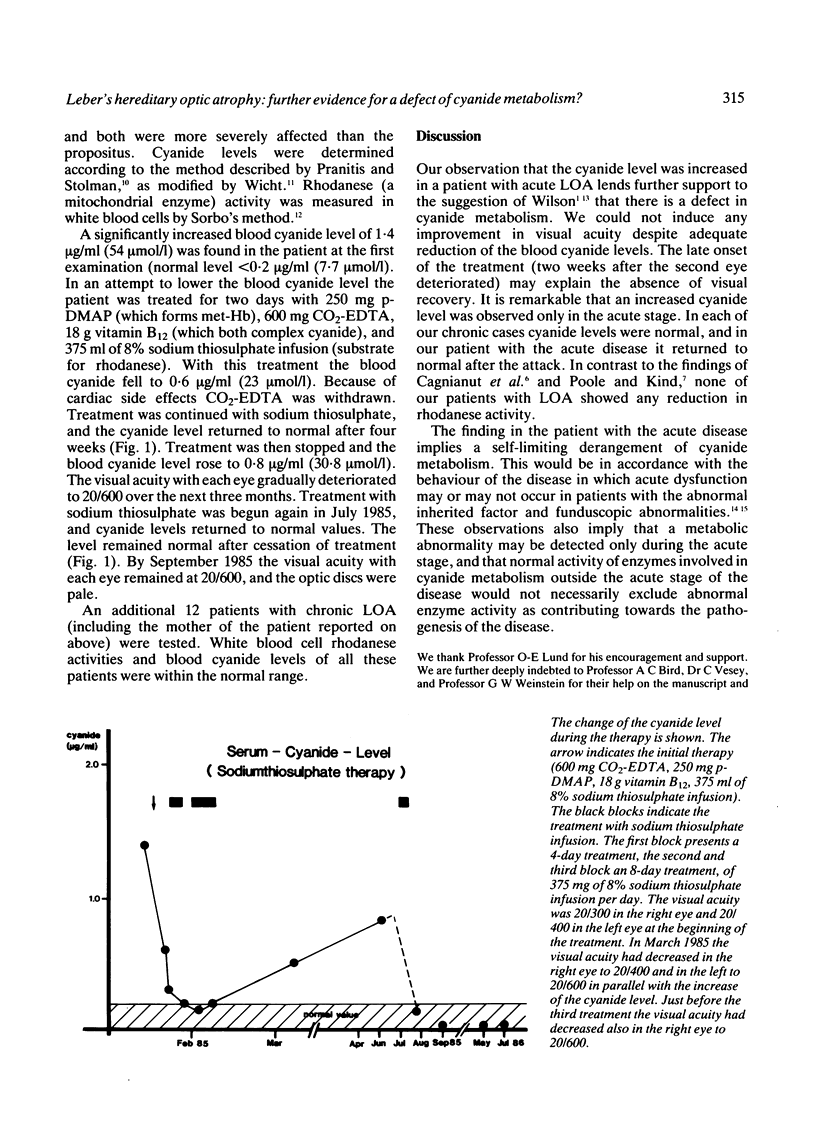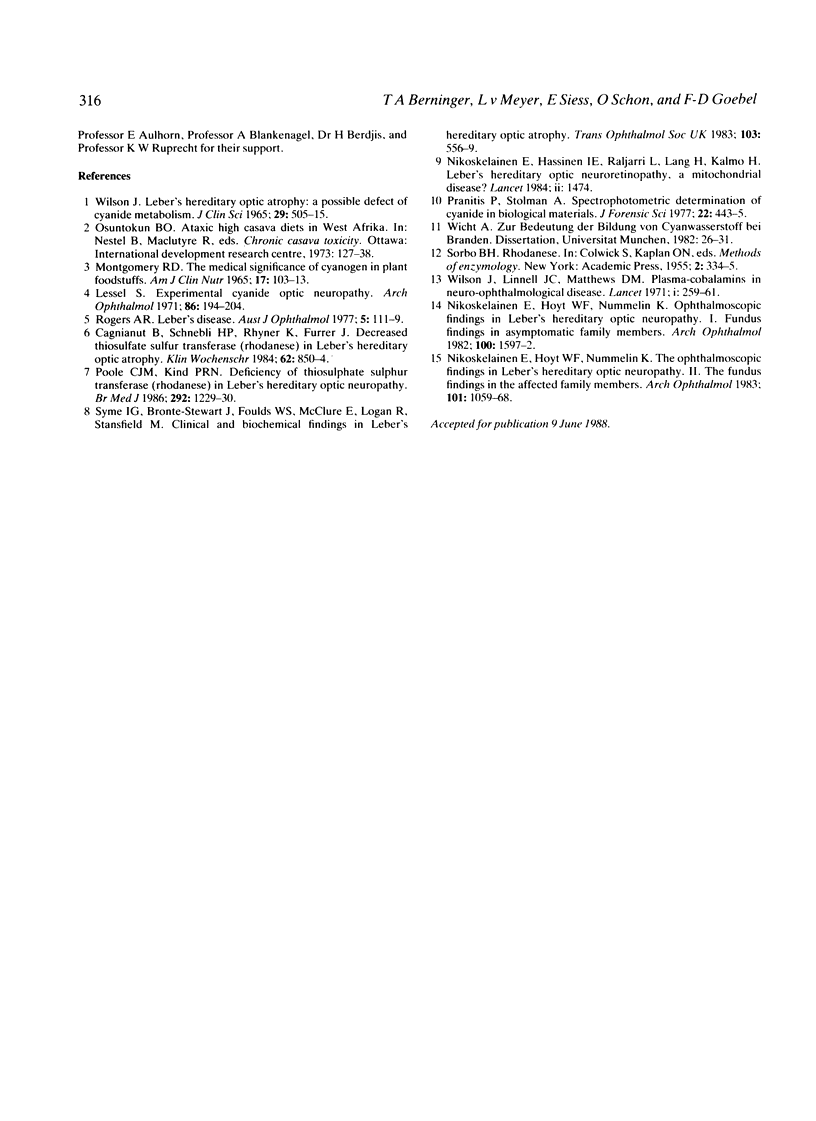Abstract
We studied one patient with Leber's optic atrophy (LOA) in the acute stage and 12 at the chronic stage of the disease, and measured the activity of rhodanese in white blood cells and the level of cyanide in whole blood. In the patient with acute disease the blood cyanide level was significantly increased at first. Treatment of this patient with cyanide antagonists reduced his cyanide level, but this was not accompanied by improvement in visual function. Rhodanese activity was normal in all patients, as were the blood cyanide levels in each of the 12 patients at the chronic stage of the disease. These findings suggest a temporary disturbance of cyanide metabolism during the acute phase of the disease in this family. The abnormal metabolic mechanism was not identified.
Full text
PDF


Selected References
These references are in PubMed. This may not be the complete list of references from this article.
- Cagianut B., Schnebli H. P., Rhyner K., Furrer J. Decreased thiosulfate sulfur transferase (rhodanese) in Leber's hereditary optic atrophy. Klin Wochenschr. 1984 Sep 17;62(18):850–854. doi: 10.1007/BF01712000. [DOI] [PubMed] [Google Scholar]
- Lessell S. Experimental cyanide optic neuropathy. Arch Ophthalmol. 1971 Aug;86(2):194–204. doi: 10.1001/archopht.1971.01000010196014. [DOI] [PubMed] [Google Scholar]
- MONTGOMERY R. D. THE MEDICAL SIGNIFICANCE OF CYANOGEN IN PLANT FOODSTUFFS. Am J Clin Nutr. 1965 Aug;17:103–113. doi: 10.1093/ajcn/17.2.103. [DOI] [PubMed] [Google Scholar]
- Nikoskelainen E., Hassinen I. E., Paljärvi L., Lang H., Kalimo H. Leber's hereditary optic neuroretinopathy, a mitochondrial disease? Lancet. 1984 Dec 22;2(8417-8418):1474–1474. doi: 10.1016/s0140-6736(84)91669-6. [DOI] [PubMed] [Google Scholar]
- Nikoskelainen E., Hoyt W. F., Nummelin K. Ophthalmoscopic findings in Leber's hereditary optic neuropathy. I. Fundus findings in asymptomatic family members. Arch Ophthalmol. 1982 Oct;100(10):1597–1602. doi: 10.1001/archopht.1982.01030040575003. [DOI] [PubMed] [Google Scholar]
- Nikoskelainen E., Hoyt W. F., Nummelin K. Ophthalmoscopic findings in Leber's hereditary optic neuropathy. II. The fundus findings in the affected family members. Arch Ophthalmol. 1983 Jul;101(7):1059–1068. doi: 10.1001/archopht.1983.01040020061011. [DOI] [PubMed] [Google Scholar]
- Poole C. J., Kind P. R. Deficiency of thiosulphate sulphurtransferase (rhodanese) in Leber's hereditary optic neuropathy. Br Med J (Clin Res Ed) 1986 May 10;292(6530):1229–1230. doi: 10.1136/bmj.292.6530.1229. [DOI] [PMC free article] [PubMed] [Google Scholar]
- Pranitis P. A., Stolman A. Spectrophotometric determination of cyanide in biological materials. J Forensic Sci. 1977 Apr;22(2):443–445. [PubMed] [Google Scholar]
- Syme I. G., Bronte-Stewart J., Foulds W. S., McClure E., Logan R., Stansfield M. Clinical and biochemical findings in Leber's hereditary optic atrophy. Trans Ophthalmol Soc U K. 1983;103(Pt 5):556–559. [PubMed] [Google Scholar]
- Wilson J. Leber's hereditary optic atrophy: a possible defect of cyanide metabolism. Clin Sci. 1965 Dec;29(3):505–515. [PubMed] [Google Scholar]
- Wilson J., Linnell J. C., Matthews D. M. Plasma-cobalamins in neuro-ophthalmological diseases. Lancet. 1971 Feb 6;1(7693):259–261. doi: 10.1016/s0140-6736(71)91000-2. [DOI] [PubMed] [Google Scholar]


